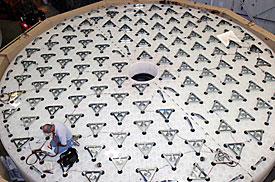 |
|
HEATHER FAULAND/Arizona Daily Wildcat
|
David Beaty, an electronics technician for the Steward Laboratory Technical Division, kneels on the underside of a telescope mirror yesterday in a lab underneath the Arizona Stadium. Beaty is working on the wiring designed to keep the $10 million mirror at the same temperature as the outside air.
|
|
|
By Ashley Nowe
Arizona Daily Wildcat
Wednesday, November 19, 2003
Print this
Astronomers move lens to Mount Graham as project nears completion
The most powerful telescope in the world is one step closer to completion after a team of UA astronomers delivered its 18-ton lens to the top of Mount Graham.
When complete, the Large Binocular Telescope will provide astronomers with a visibility 25 times greater than the Hubble space craft.
"We are very excited about this," said Peter Wehinger, a staff astronomer. "It will be like going where no astronaut has gone before."
The quality of the telescope will also be more precise than other telescopes with the use of adaptive optics, a modern technique that filters out earth's turbulence.
"This technique basically takes the twinkle out of the star," Wehinger said. "We will be able to see things that we have never seen before with this sharpness."
The telescope will be functional early next summer, but it will have only half the power that it will have when completed.
The second piece of glass is in the process of being made in the Steward Observatory Mirror Lab.
The final telescope, which will be 16 stories high, will utilize both pieces of glass, which cost $22 million.
By placing the two glass mirrors on top of one another, it will not only make the telescope the most powerful in the world, but it will allow for depth perception.
"It is like using binoculars. When you use binoculars, the image appears closer, but you can also retain depth perception," said James H. Slagle, the assistant director of the Large Binocular Telescope project. "This allows us to look at planets like never before by understanding the depth of the mass."
The team expects the second piece of glass to travel up the mountain in early February, and the entire telescope should be ready by 2005.
"It is all about exploration," Wehinger said. "If you knew what you were going to find, you wouldn't build it. That is what big telescopes are for."
The first piece of glass arrived atop the 10,480-foot peak late October.
A transporting truck took over the road as it carried the glass and its steel frame, together weighing 55 tons.
Approximately 25 police vehicles escorted the truck through the streets of Tucson and up I-10 and State Highway 191 before climbing the mountain at one mph.
"For us this is like moving a very expensive jewel," Slagle said. "The safety of this piece of glass was so crucial to us."
The glass left the UA at 3 a.m., taking two and a half days to make it to the mountain top.
It was transported by a 48-wheel truck, each wheel on its own hydraulic system, allowing for the truck to remain stable on the uphill dirt roads.
The glass stood at a 60-degree angle inside the truck bed.
"The only way we could get this thing up there was to set it on its side," Slagle said. "That was the only way to fit it through the compacted mountain. It was just too big."
The truck took over two lanes and traffic was blocked for hours while the truck climbed the mountain.
With each turn, the piece of glass that stretches 28-feet in diameter was monitored closely by those involved in the project.
The glass was placed inside the telescope, but it still needs to be hooked into its casing.
After computer programming is worked out, the telescope will function.
"This thing is just incredible," Slagle said. "The UA has the most extraordinary telescope in the entire world. That is pretty neat."
